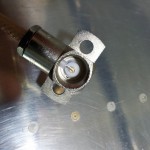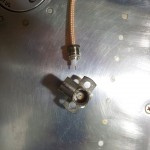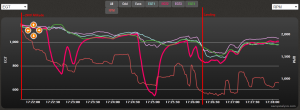No, not superman, actually, it is a plane.
After nearly six years of construction and 1950 hours in the shop (not counting the time spent researching, planning, ordering parts, and so on), today was the big day. We couldn’t have had better weather if it had been custom ordered. Clear skies, winds practically dead calm, and impressive flight visibility for most of the day.
I met test pilot and transition trainer Tom Berge at the airport shortly after 7am, and we discussed the plan for the day. I needed to complete 3 more hours of transition training in Tom’s RV-7A, and then there was the first flight business. Tom needed to fly my plane for a full hour to satisfy insurance requirements and verify the data from the first flight. So we decided that we would do half the training, come back to inspect, reassemble, and fly my plane; then finish the transition training, and then the remainder of the first hour on my plane. We flew the first 1:45 of training, focused on emergency procedures, to the north and came back to Red Wing.
Tom worked through his final inspection of the plane, and I worked on installing the inspection panels and cowling while Allison was treated to a quick hop in Tom’s 7A. Then it was ready to go, after talking through the systems and instrument panel. Pulled the plane out and started her up, and he headed off to the runup area for the final ground checks. By the time Allison & I walked out to the taxiway, he was almost ready to go, and an uneventful takeoff and climbout ensued. He circled the airport for several laps before heading to the northeast to climb up and explore stalls and slow flight, and determine airspeeds and power settings for the pattern. A quick call on the radio let me know everything was working fine so far. After 35 minutes or so, back to the airport for landing (which happened down at the far end of the airport, so no photos of the actual landing).
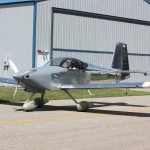
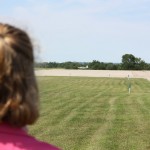
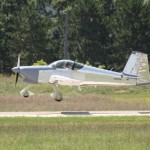
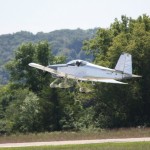
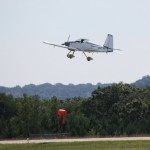
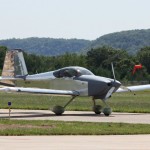
Off to lunch for food and discussion, then we headed south for the remainder of the transition training; we headed to Winona, which is the southernmost point of my small test flight area (which is essentially 1/4 of a 30NM radius circle from Red Wing: KRGK-3T3-KLUM-KONA-KRGK). Stalls, slips, and aborted takeoffs this time, then back to Red Wing.
Another half hour or so of test flight by Tom got us to 1.1 of flight time on the plane so far. By the time he headed back to the airport, Bob Collins and Brad, another local RV builder, had stopped by to say hi, Bob having just finished his 40 hour flight test period. After Tom landed and taxied back, I snapped this photo of the three RV’s lined up on the ramp.
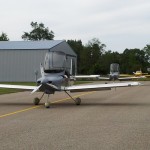
Tom & I talked through the list of squawks, transfer of knowledge on the pattern flying power settings & airspeeds he determined during his test flights, then he signed the logbooks and turned the keys over to me. I decided to take a bit of a walk to relax and breathe a bit before taking the plane up myself. Tom departed in his 7A, and after 15 or 20 minutes, and readjusting the seats & harnesses, it was time to head up. The winds were still calm, though the summer haze had returned as the day wore on. Taxi and runup, radio call, takeoff…yep, she flies like an airplane. I flew a similar profile as the first flight: several racetracks over the field climbing to 4500′, then off to the northeast for stalls and pattern simulation at 5500′. After flying around for a bit east of Ellsworth, I brought it back to the airport and descended to pattern altitude…the first approach ended up being quite high–as I’d really expected it to be, since this plane doesn’t come down as readily as the 7A. For experience, I held the descent to about 100′, then went around again. Adjusting the second pattern resulted in a fine approach and landing.
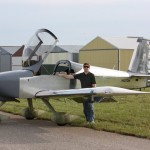
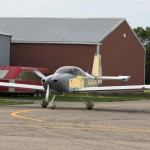
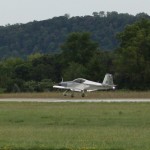
She flies! The stick forces are significantly higher than I had grown used to in the 7A, it really takes a solid pull to hold full up elevator. Roll rate is slower than the 7A, so it’s not quite as “fun,” but feels more solid and stable. As with any complex piece of machinery, there are several bugs to work out (including weak radio and a heavy left wing), but we’ll get there in due time. It’s going to be fun.
(There is video from the first flights, many GB of it; I’ll post it once I’ve cut it down to a not-overwhelming montage, and wait for it to upload over my wee DSL uplink.)
This has been a major project, and I couldn’t have done it alone, there are many people to thank…a bunch of locals, Pete Howell (RV-9A, whose travel stories are an inspiration unto themselves), Mike Behnke (RV-9A, who gave my first RV ride, and who my panel design is modeled after), Bob Collins (RV-7A, author and collector of RV stories on his website, inspiration, and help with the airworthiness documentation), and the others who I’ve met or planes I’ve looked at during the builder’s club meetings. The online RV community and all the folks who post their build logs on the web for us others to research and steal ideas from.
The inimitable Tom Berge, for putting up with me through 15 hours of transition training (boost pump off, don’t raise the nose!), advice on the plane and flying in general, and putting his life on the line for the first flight.
And of course, to Allison, who has tolerated parts and plans scattered around the house…fuel tanks in the living room…her car being kicked out of the garage to make way for larger airplane parts…my lack of lawn care in favor of more shop time…all the lonely evenings with me hiding in the shop or hangar (it’ll be different having me around the house again, I’m sure)…airplane purchases draining money out of our account as fast as we can put it back in… And through all of it, managed to smile and tell me I should quit complaining and get back to the shop.
Add one to the big board … N627DW has flown.
